

In JDF, the finishing operations like punch, fold and staple are applied on the trailing edge (left) of the job, or the top left corner of the trailing edge (top left). To set the finishing operations on other edges, the input of a finishing process must be transformed. Transformations are applied as follows:
Rotate the media sheet counter clockwise.
If Flip is specified, flip the media sheet upside down. After this rotation, the top edge is on the bottom and the back side is on the front.
Apply finishing on the new left edge, or the new top left corner, after the transformation.
The media sheet is always considered as portrait-oriented, i.e the left edge is always the large edge, regardless of the orientation of the content.
Syntax for input
XPath: /JDF/ResourceLinkPool/ComponentLink[@Usage=”Input” and @CombinedProcessIndex]]/@Orientation
Syntax for output
XPath: /JDF/ResourceLinkPool/ComponentLink[@Usage=”Output” and @CombinedProcessIndex]/@Orientation
Supported values
|
@Orientation values |
Trailing edge |
Corner |
|---|---|---|
|
Rotate0 (default) |
Left |
LeftTop |
|
Rotate90 |
Top |
TopRight |
|
Rotate180 |
Right |
RightBottom |
|
Rotate270 |
Bottom |
BottomLeft |
|
Flip0 |
Left |
LeftBottom |
|
Flip90 |
Top |
TopLeft |
|
Flip180 |
Right |
RightTop |
|
Flip270 |
Bottom |
BottomRight |
Description
In case several successive finishing options are specified, the ComponentLink[@Usage=”Output”] must be specified.
@CombinedProcessIndex is an integer which refers to the Process index on which the transformation must be applied. The Process index is the position of the Process in the JDF node attribute @Types, starting with zero.
Example: Staple dual top
<JDF ID="jdf_1" Type="Combined" Category="DigitalPrinting" Types="LayoutPreparation Imposition Interpreting Rendering DigitalPrinting Stitching">
<ResourcePool>
<Component ID="Product_4" Class="Quantity" Status="Unavailable" ComponentType="PartialProduct"/>
<StitchingParams ID="ProcessID_5" Class="Parameter" Status="Available" StitchType="Side" NumberOfStitches="2"/>
<Component ID="Product_5" Class="Quantity" Status="Unavailable" ComponentType="PartialProduct"/>
</ResourcePool>
<ResourceLinkPool>
<ComponentLink rRef="Product_4" Usage="Input" Orientation="Flip90" CombinedProcessIndex="5"/>
<StitchingParamsLink rRef="ProcessID_5" Usage="Input"/>
<ComponentLink rRef="Product_5" Usage="Output" Orientation="Flip270" CombinedProcessIndex="5"/>
</ResourceLinkPool>
</JDF>
Syntax
XPath:
//StitchingParams/@NoOp
//HoleMakingParams/@NoOp
//FoldingParams/@NoOp
//TrimmingParams/@NoOp
//CoverApplicationParams/@NoOp
//CreasingParams/@NoOp
Type
Boolean
Supported range
|
@NoOp |
Description |
|---|---|
|
false (default) |
The process must be applied. |
|
true |
The process must not be applied (i.e the parameters are ignored). |
Description
It is possible to describe an optional process (like a finishing process) that the device must not execute but is nevertheless present in the ticket.
The @NoOp attribute is only supported for the following processes: Stitching, HoleMaking, Creasing, Folding, Trimming and CoverApplication.
Example: Double staples for the whole job except for the first four pages
<JDF ID="jdf_1" Type="Combined" Category="DigitalPrinting" Types="LayoutPreparation Imposition Interpreting Rendering DigitalPrinting Stitching">
<ResourcePool>
<StitchingParams ID="ProcessID_5" Class="Parameter" Status="Available" PartIDKeys="RunIndex" StitchType="Side" NumberOfStitches="2">
<StitchingParams RunIndex="1 ~ 4" NoOp="true"/>
</StitchingParams>
</ResourcePool>
<ResourceLinkPool>
<StitchingParamsLink rRef="ProcessID_5" Usage="Input"/>
</ResourceLinkPool>
</JDF>
Syntax
XPath: /JDF[contains(@Types=“HoleMaking”)]/ResourcePool/HoleMakingParams/@HoleType
Type
Enumeration
Supported range
|
@HoleType |
Number of holes |
|---|---|
|
None |
- |
|
S-generic |
Punching required but number of holes is unknown. |
|
R2-generic |
2 |
|
R3-generic |
3 |
|
R4-generic |
4 |
Description
When punching is required, @HoleType defines the number of holes to make.
The Punching position is specified via:
/JDF/ResourceLinkPool/ComponentLink[
@Usage=”Input” and
@Orientation and
@CombinedProcess]
Example: Punching with 2 holes
<JDF Types="LayoutPreparation Imposition Interpreting Rendering DigitalPrinting HoleMaking">
<ResourcePool>
<HoleMakingParams ID="res_9" HoleType="R2-generic"/>
</ResourcePool>
<ResourceLinkPool>
<HoleMakingParamsLink rRef="res_9" Usage="Input"/>
</ResourceLinkPool>
</JDF>
Syntax
XPath: //CreasingParams/Crease/@RelativeStartPosition
Type
XYPair
Supported values
The values must be "0.5 0" or "0 0.5".
Syntax
XPath: //CreasingParams/Crease/@RelativeWorkingPath
Type
XYPair
Supported values
The values must be "0 1" or "1 0".
Description
You have to use both @RelativeStartPosition and @RelativeWorkingPath to define the crease.
The allowed value of the XYPair of @RelativeStartPosition is "0.5 0", which specifies a half fold of the sheet.
The allowed value of the XYPair of @RelativeWorkingPath is "0 1", which specifies a crease over the width of the sheet.
It is allowed to switch the values for X and Y.
Example
<JDF Type ="Combined" Types ="... Creasing ...">
<ResourcePool>
<CreasingParams ID = "res_1" Class = "Parameter" Status = "Available">
<Crease RelativeStartPosition = "0.5 0" RelativeWorkingPath = "0 1">
</Crease>
</CreasingParams>
</ResourcePool>
<ResourceLinkPool>
<CreasingParamsLink rRef = "res_1" Usage = "Input"/>
</ResourceLinkPool>
</JDF>
Remark
The tool can apply a crease only parallel to the leading/trailing edge, over the full width and only at the half fold position.
There is no support for the creasing orientation, therefore 2 orientations are accepted.
There is no support for direct control of the WorkingDirection [Top, Bottom]. Both will be the result of other finishing settings that control facing or feed direction.
Syntax
XPath: //CreasingParams/Crease/GeneralID[@IDUsage="oce:CreasePattern"]@IDValue
Type
NMTOKEN
Supported range
|
@IDValue |
CreasePattern |
|---|---|
|
FoldCatalog |
As defined by FoldCatalog |
Syntax
XPath: //CreasingParams/Crease/GeneralID[@IDUsage=”oce:FoldCatalog”]@IDValue
Type
NMTOKEN
Supported range
|
@IDValue |
Fold method |
|---|---|
|
F4-1 |
Half fold |
Example for creasing using CreasePattern = FoldCatalog and a RunIndex
Creasing for specific pages using RunIndex Partition. The RunIndex refers to the sheets of the given pages. When you don't use the RunIndex, the creasing is applied to all sheets:
<JDF Type ="Combined" Types ="... Creasing ...">
<ResourcePool>
<CreasingParams ID = "res_1" Class = "Parameter" Status = "Available" PartIDKeys ="RunIndex">
<CreasingParams RunIndex="0 ~ 5 6 ~ 10 11 ~ 15">
<GeneralID IDUsage = "oce: CreasePattern" IDValue = "FoldCatalog"/>
<GeneralID IDUsage = "oce: FoldCatalog" IDValue = "F4-1 "/>
</CreasingParams>
</CreasingParams>
</ResourcePool>
<ResourceLinkPool>
<CreasingParamsLink rRef = "res_1" Usage = "Input"/>
</ResourceLinkPool>
</JDF>
Remark
The tool can apply a crease only parallel to the leading/trailing edge, over the full width and only at the half fold position.
There is no support for the creasing orientation, therefore 2 orientations are accepted.
There is no support for direct control of the WorkingDirection [Top, Bottom]. Both will be the result of other finishing settings that control facing or feed direction.
Syntax
XPath: //CreasingParams/Crease/GeneralID[@IDUsage=”oce:CreaseCondition”]@IDValue
Type
NMTOKEN
Supported range
|
@IDValue |
CreaseCondition |
|---|---|
|
All (default) |
All sheets of the subset |
|
FirstOfSubset |
Only first sheet of subset |
|
LastOfSubset |
Only last sheet of subset |
|
FirstAndLastOfSubset |
Only first and last sheet of subset |
Example
<JDF Type ="Combined" Types ="... Creasing ...">
<ResourcePool>
<CreasingParams ID = "res_1" Class = "Parameter" Status = "Available">
<GeneralID IDUsage = "oce: CreasePattern" IDValue = "FoldCatalog"/>
<GeneralID IDUsage = "oce: FoldCatalog" IDValue = "F4-1"/>
<GeneralID IDUsage = "oce: CreaseCondition" IDValue = "FirstOfSubset"/>
</CreasingParams>
</ResourcePool>
<ResourceLinkPool>
<CreasingParamsLink rRef = "res_1" Usage = "Input"/>
</ResourceLinkPool>
</JDF>
Remark
The tool can apply a crease only parallel to the leading/trailing edge, over the full width and only at the half fold position.
There is no support for the creasing orientation, therefore 2 orientations are accepted.
There is no support for direct control of the WorkingDirection [Top, Bottom]. Both will be the result of other finishing settings that control facing or feed direction.
Syntax for the fold catalogue
XPath: /JDF[contains(@Types=“Folding”)]/ResourcePool/FoldingParams/@FoldCatalog
Type
String
Supported range
|
@FoldCatalog |
Fold method |
|---|---|
|
F4-1 |
Single half-fold |
|
F6-7 |
Z-fold |
Syntax for the direction
XPath: /JDF/ResourcePool/LayoutPreparationParams/@PresentationDirection
Type
Enumeration
Supported range
|
@PresentationDirection |
Description |
|---|---|
|
XyZ |
Outside |
Description
The @PresentationDirection is optional:
Unspecified @PresentationDirection means inside folding.
The @PresentationDirection="XyZ" attribute means outside folding
See the table "FoldCatalog and PresentationDirection" below for all possible values for @FoldCatalog and @PresentationDirection.
Syntax for the finishing order
XPath: /JDF/ResourcePool/LayoutPreparationParams/@FinishingOrder
Type
Enumeration
Supported range
|
@FinishingOrder |
Fold method |
|---|---|
|
FoldGather |
Single sheet fold |
|
GatherFold |
Multi sheet fold |
Description
With @FinishingOrder = “GatherFold” you specify the folding of several sheets.
For multi folding, use the LayoutPreparationParams element to define the amount of sheets to be folded.
This table lists all possible values for @FoldCatalog and @PresentationDirection. However, your PRISMAsync Print Server only supports the following folding methods:
|
@FoldCatalog |
Fold method |
|---|---|
|
F4-1 |
Single half-fold |
|
F6-7 |
Z-fold |
|
Intent |
FoldingParams /@FoldCatalog |
LayoutPreparationParams /@PresentationDirection (Default is "Xyz") |
Result |
|---|---|---|---|
|
Half fold with first page inside |
F4-1 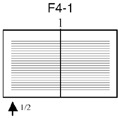
|
(unspecified) |
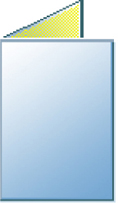
|
|
Half fold with first page outside |
xyz |
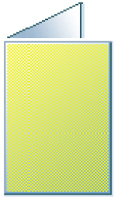
|
|
|
Z fold larger sheets |
F6-7 + with the addition of Flip180 in both Input and Output ComponentLink. @oce:ZFoldLargeSheetsOnly ="true" 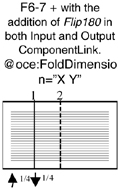
|
(unspecified) |
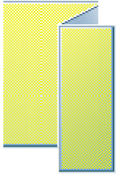
|
|
Tri-fold-out with first page inside |
F6-1 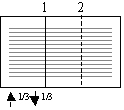
|
(unspecified) |

|
|
Tri-fold-out with first page outside |
xyz |

|
|
|
Tri-fold-in with first page inside |
F6-4 
|
(unspecified) |

|
|
Tri-fold-in with first page outside |
xyz |

|
|
|
Parallel fold with first page inside |
F8-2 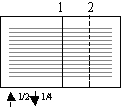
|
(unspecified) |

|
|
Parallel fold with first page outside |
xyz |

|
Syntax for number of stitches
XPath: /JDF[contains(@Types=“Stitching”)]/ResourcePool/StitchingParams/@NumberofStitches
Type
Integer
Supported range
[0 .. 2]
Syntax for stitch type
XPath: /JDF[contains(@Types=“Stitching”)]/ResourcePool/StitchingParams/@StitchType
Type
Enumeration
Supported range
|
@StitchType |
Description |
|---|---|
|
Corner |
Corner staple (default position is upper-left corner) |
|
Side |
Side staple (default position is left side) |
|
Saddle |
Saddle stitching |
Description
The position of the staple can be changed with:
/JDF[contains(@Types=“Stitching”)]/ResourceLinkPool/ComponentLink[
@Usage=”Input” and
@Orientation and
@CombinedProcessIndex]
The attribute @CombinedProcessIndex corresponds to the ID of “Stitching” in /JDF/@Types.
Example: Dual top staple (landscape oriented)
<JDF ID="jdf_1" Type="Combined" Category="DigitalPrinting" Types="LayoutPreparation Imposition Interpreting Rendering DigitalPrinting Stitching">
<ResourcePool>
<Component ID="Product_4" Class="Quantity" Status="Unavailable" ComponentType="PartialProduct"/>
<StitchingParams ID="ProcessID_5" Class="Parameter" Status="Available" StitchType="Side" NumberOfStitches="2"/>
<Component ID="Product_5" Class="Quantity" Status="Unavailable" ComponentType="PartialProduct"/>
</ResourcePool>
<ResourceLinkPool>
<ComponentLink rRef="Product_4" Usage="Input" Orientation="Flip0" CombinedProcessIndex="5"/>
<StitchingParamsLink rRef="ProcessID_5" Usage="Input"/>
<ComponentLink rRef="Product_5" Usage="Output" Orientation="Flip0" CombinedProcessIndex="5"/>
</ResourceLinkPool>
</JDF>
Remark
Stitching is supported on all products that use an HW configuration that allows stitching. However, not all staple positions are available on every output device. The contradictions are reported on the product UI.
The following table shows how components with different binding edges must be rotated and/or flipped to get the stapling location in the top left hand corner (1 staple) or on the left hand side (2 staples):
|
ComponentLink/@Orientation |
//Media/@Dimension is Portrait |
//Media/@Dimension is Landscape |
|---|---|---|
|
@Orientation not specified |

|

|
|
"Flip0" |
||
|
"Rotate0" |
||
|
"Flip90" |

|

|
|
"Rotate90" |
||
|
"Flip180" |

|

|
|
"Rotate180" |
||
|
"Flip270" |

|

|
|
"Rotate270" |
|
ComponentLink/@Orientation |
//Media/@Dimension is Portrait |
//Media/@Dimension is Landscape |
|---|---|---|
|
@Orientation not specified |

|

|
|
"Flip90" |
||
|
"Rotate0" |
||
|
"Flip180" |

|

|
|
"Rotate90" |
||
|
"Flip270" |

|

|
|
"Rotate180" |
||
|
"Flip0" |

|

|
|
"Rotate270" |
Syntax
XPath: /JDF/ResourcePool/DigitalPrintingParams/@OutputBin
Type
String
Supported range
|
Destination |
@OutputBin |
|---|---|
|
HCS1 |
LargeCapacity LargeCapacity-1 |
|
HCS2 |
LargeCapacity-2 |
|
HCS3 |
LargeCapacity-3 |
|
Upper bin |
Top |
|
OEM finisher |
ExternalFinisher |
|
Finisher |
Finisher |
|
Stacker stapler main tray |
StackerStapler |
|
Stacker stapler top tray |
StackerTray |
The high capacity stackers are numbered from left to right.